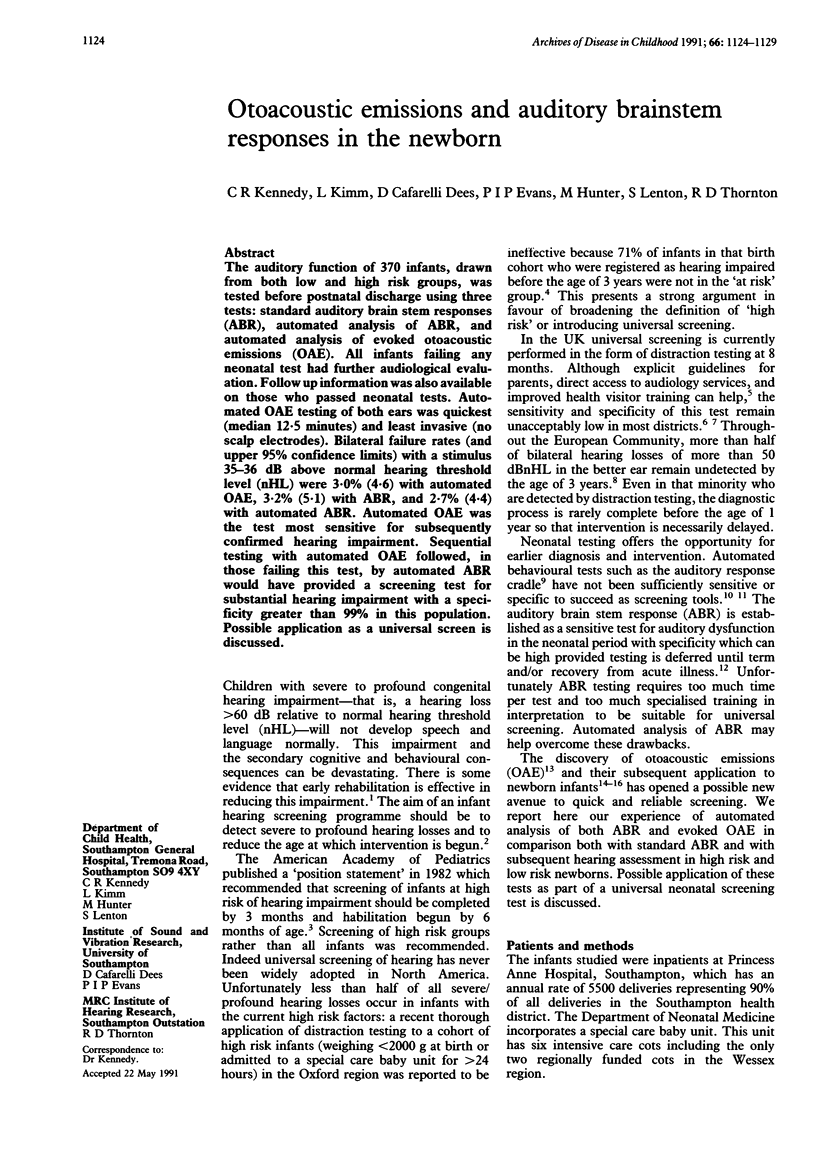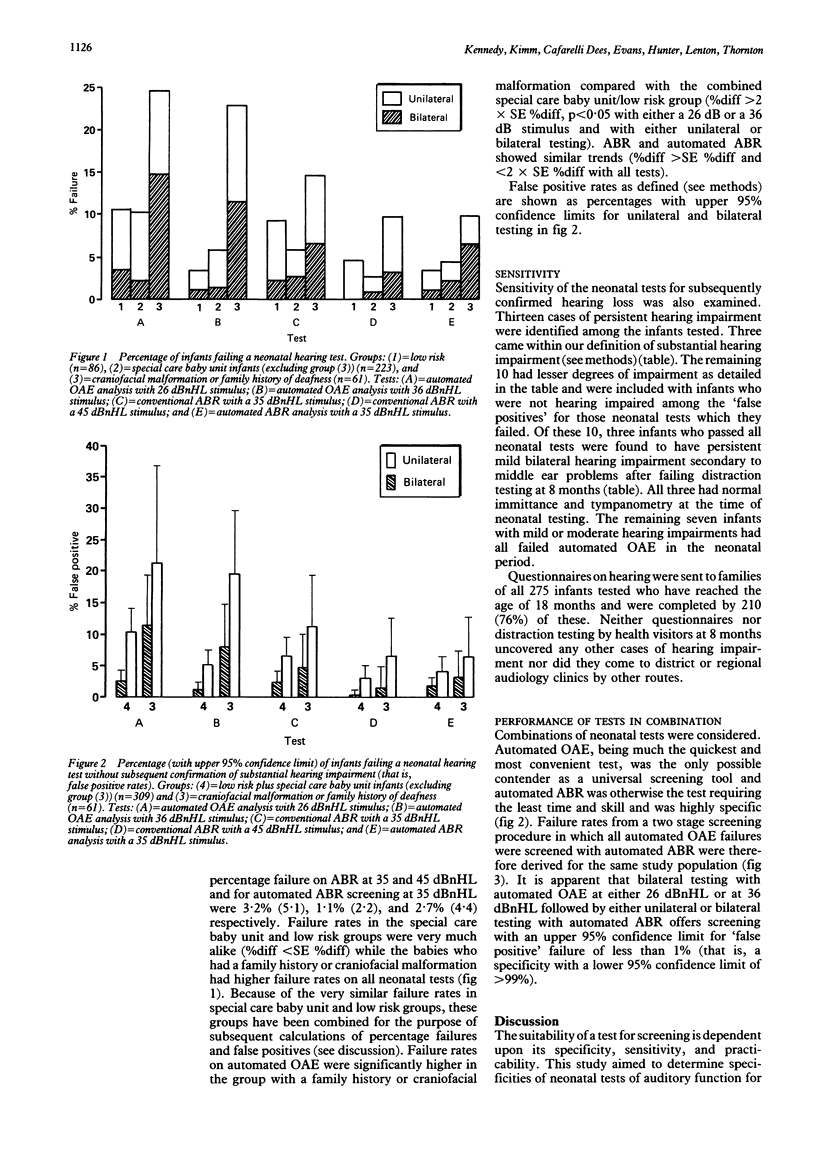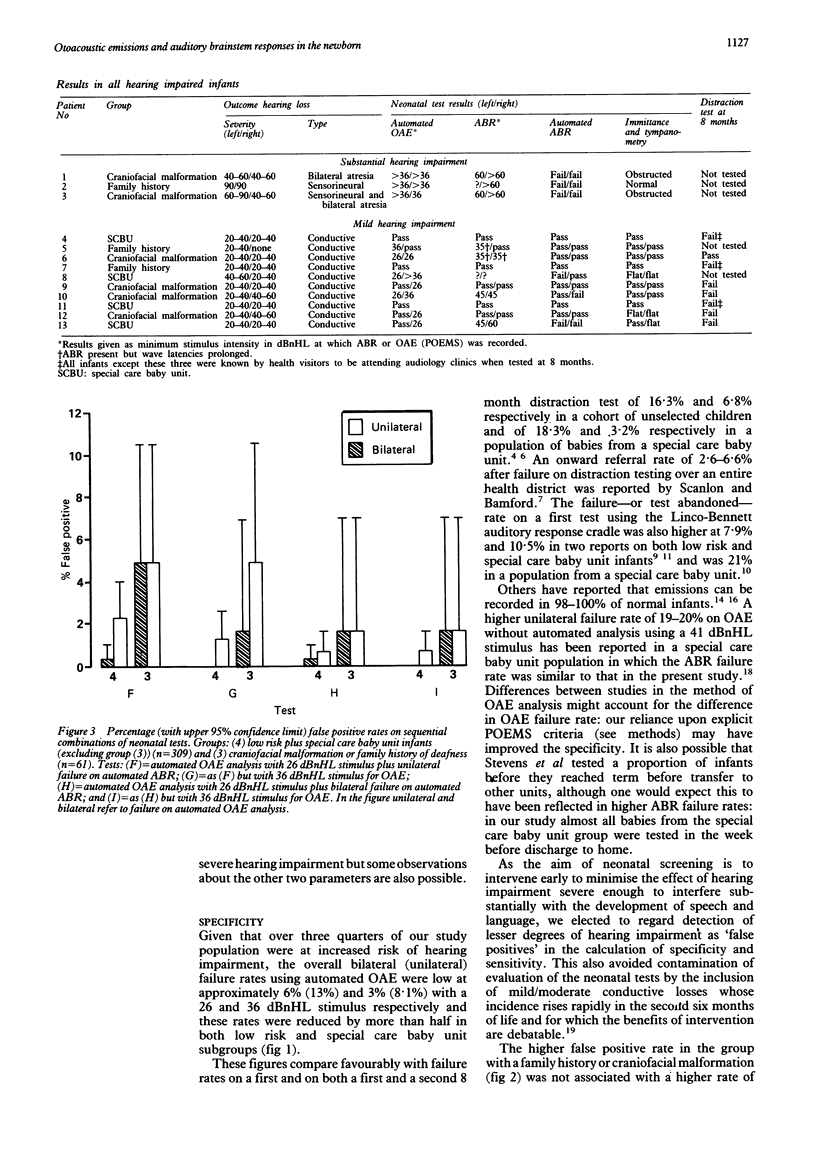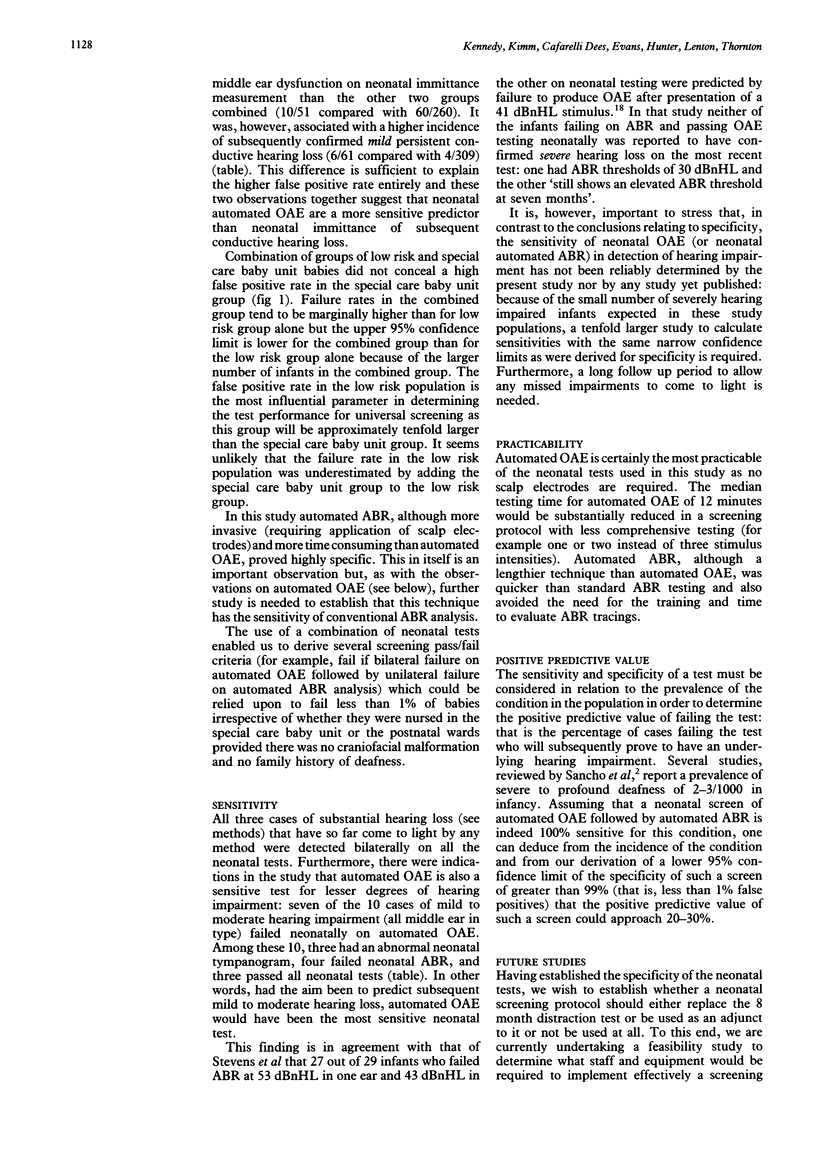Abstract
The auditory function of 370 infants, drawn from both low and high risk groups, was tested before postnatal discharge using three tests: standard auditory brain stem responses (ABR), automated analysis of ABR, and automated analysis of evoked otoacoustic emissions (OAE). All infants failing any neonatal test had further audiological evaluation. Follow up information was also available on those who passed neonatal tests. Automated OAE testing of both ears was quickest (median 12.5 minutes) and least invasive (no scalp electrodes). Bilateral failure rates (and upper 95% confidence limits) with a stimulus 35-36 dB above normal hearing threshold level (nHL) were 3.0% (4.6) with automated OAE, 3.2% (5.1) with ABR, and 2.7% (4.4) with automated ABR. Automated OAE was the test most sensitive for subsequently confirmed hearing impairment. Sequential testing with automated OAE followed, in those failing this test, by automated ABR would have provided a screening test for substantial hearing impairment with a specificity greater than 99% in this population. Possible application as a universal screen is discussed.
Full text
PDF





Selected References
These references are in PubMed. This may not be the complete list of references from this article.
- Bhattacharya J., Bennett M. J., Tucker S. M. Long term follow up of newborns tested with the auditory response cradle. Arch Dis Child. 1984 Jun;59(6):504–511. doi: 10.1136/adc.59.6.504. [DOI] [PMC free article] [PubMed] [Google Scholar]
- Bonfils P., Dumont A., Marie P., Francois M., Narcy P. Evoked otoacoustic emissions in newborn hearing screening. Laryngoscope. 1990 Feb;100(2 Pt 1):186–189. doi: 10.1288/00005537-199002000-00015. [DOI] [PubMed] [Google Scholar]
- Brown J., Watson E., Alberman E. Screening infants for hearing loss. Arch Dis Child. 1989 Oct;64(10):1488–1495. doi: 10.1136/adc.64.10.1488. [DOI] [PMC free article] [PubMed] [Google Scholar]
- Elberling C., Parbo J., Johnsen N. J., Bagi P. Evoked acoustic emission: clinical application. Acta Otolaryngol Suppl. 1985;421:77–85. doi: 10.3109/00016488509121760. [DOI] [PubMed] [Google Scholar]
- Haggard M. P. Hearing screening in children--state of the art(s) Arch Dis Child. 1990 Nov;65(11):1193–1195. doi: 10.1136/adc.65.11.1193. [DOI] [PMC free article] [PubMed] [Google Scholar]
- Hall D. M., Garner J. Feasibility of screening all neonates for hearing loss. Arch Dis Child. 1988 Jun;63(6):652–653. doi: 10.1136/adc.63.6.652. [DOI] [PMC free article] [PubMed] [Google Scholar]
- Johnson A., Ashurst H. Screening for sensorineural deafness by health visitors. The Steering Committee, Oxford Region Child Development Project. Arch Dis Child. 1990 Aug;65(8):841–845. doi: 10.1136/adc.65.8.841. [DOI] [PMC free article] [PubMed] [Google Scholar]
- Kemp D. T. Stimulated acoustic emissions from within the human auditory system. J Acoust Soc Am. 1978 Nov;64(5):1386–1391. doi: 10.1121/1.382104. [DOI] [PubMed] [Google Scholar]
- Markides A. Age at fitting of hearing aids and speech intelligibility. Br J Audiol. 1986 May;20(2):165–167. doi: 10.3109/03005368609079011. [DOI] [PubMed] [Google Scholar]
- Martin J. A., Bentzen O., Colley J. R., Hennebert D., Holm C., Iurato S., de Jonge G. A., McCullen O., Meyer M. L., Moore W. J. Childhood deafness in the European community. Scand Audiol. 1981;10(3):165–174. doi: 10.3109/01050398109076177. [DOI] [PubMed] [Google Scholar]
- McCormick B., Curnock D. A., Spavins F. Auditory screening of special care neonates using the auditory response cradle. Arch Dis Child. 1984 Dec;59(12):1168–1172. doi: 10.1136/adc.59.12.1168. [DOI] [PMC free article] [PubMed] [Google Scholar]
- McCormick B. Hearing screening by health visitors: a critical appraisal of the distraction test. Health Visit. 1983 Dec;56(12):449–451. [PubMed] [Google Scholar]
- Murray A. D., Javel E., Watson C. S. Prognostic validity of auditory brainstem evoked response screening in newborn infants. Am J Otolaryngol. 1985 Mar-Apr;6(2):120–131. doi: 10.1016/s0196-0709(85)80050-8. [DOI] [PubMed] [Google Scholar]
- Scanlon P. E., Bamford J. M. Early identification of hearing loss: screening and surveillance methods. Arch Dis Child. 1990 May;65(5):479–485. doi: 10.1136/adc.65.5.479. [DOI] [PMC free article] [PubMed] [Google Scholar]
- Stevens J. C., Webb H. D., Hutchinson J., Connell J., Smith M. F., Buffin J. T. Click evoked otoacoustic emissions compared with brain stem electric response. Arch Dis Child. 1989 Aug;64(8):1105–1111. doi: 10.1136/adc.64.8.1105. [DOI] [PMC free article] [PubMed] [Google Scholar]
- Stevens J. C., Webb H. D., Smith M. F., Buffin J. T. The effect of stimulus level on click evoked oto-acoustic emissions and brainstem responses in neonates under intensive care. Br J Audiol. 1990 Oct;24(5):293–300. doi: 10.3109/03005369009076569. [DOI] [PubMed] [Google Scholar]


